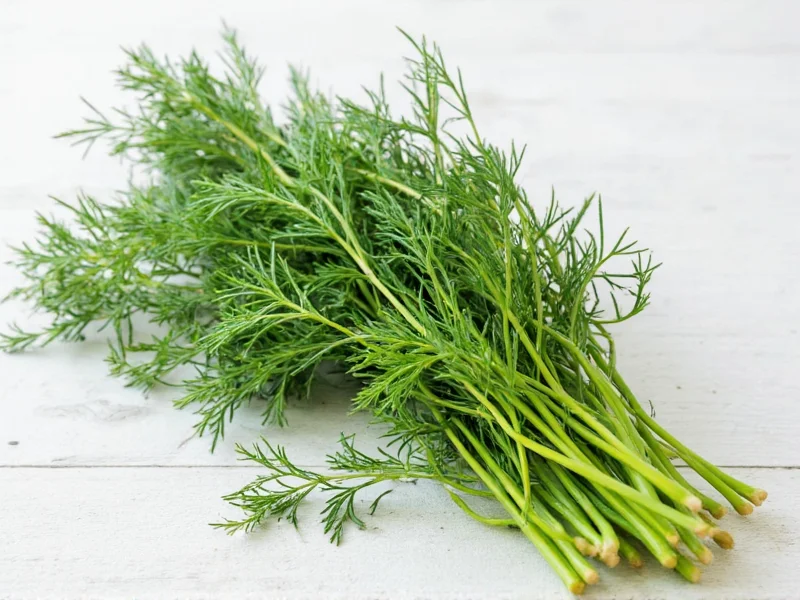Running out of dill while cooking doesn't have to ruin your recipe. Whether you're preparing Scandinavian gravlax, Russian borscht, or homemade pickles, understanding proper dill alternatives ensures your dish maintains its intended flavor profile. This comprehensive guide explores scientifically-backed substitutions that preserve culinary integrity while accommodating ingredient limitations.
Understanding Dill's Unique Flavor Chemistry
Dill's distinctive taste comes from compounds like carvone and limonene, creating its characteristic grassy, citrusy, and slightly anise-like flavor. When seeking dill substitutes for cooking, you're essentially trying to replicate this complex flavor profile. Fresh dill has a more delicate taste than its dried counterpart, which concentrates the essential oils and develops earthier notes. This fundamental difference explains why substitution ratios vary between fresh and dried forms.
Top Fresh Herb Alternatives
When substituting fresh dill, consider both flavor compatibility and texture. The best fresh dill substitute for fish dishes differs from what works in tzatziki or potato salad. Here's how the top alternatives compare:
| Substitute | Best For | Substitution Ratio | Flavor Notes |
|---|---|---|---|
| Tarragon | Cream sauces, egg dishes, chicken | 1:1 | Slightly sweeter with pronounced anise notes |
| Fennel fronds | Seafood, salads, roasted vegetables | 1:1 | Milder licorice flavor, excellent texture match |
| Parsley + dill weed | Universal substitute | 2:1 ratio (2 parts parsley, 1 part dill weed) | Balances grassiness with subtle dill flavor |
| Basil | Mediterranean dishes, tomato-based recipes | 3/4:1 | Sweeter profile, use sparingly to avoid overpowering |
Dried Herb Substitutes Explained
Finding a dried dill substitute requires understanding concentration differences. Dried herbs are typically three times more potent than fresh, but dill's essential oils degrade significantly when dried. The most reliable dried alternatives include:
- Dill seed: Use 1/3 teaspoon for every teaspoon of dried dill required. Has a stronger, more pungent flavor with citrus notes
- Caraway seeds: Substitute 1/4 teaspoon crushed caraway per teaspoon dried dill. Shares similar chemical compounds but has a more intense flavor
- Dried tarragon: Use 1/2 teaspoon for every teaspoon of dried dill. Maintains the anise-like quality better than most dried alternatives
- Dill pickle juice: 1 tablespoon replaces 1 teaspoon dried dill in dressings and marinades
Recipe-Specific Substitution Guide
The ideal dill substitute varies dramatically by dish type. Understanding these nuances prevents culinary disasters when replacing this versatile herb:
For Pickling and Preserving
When seeking the best dill substitute for pickling, dill seed becomes your primary option. Use one dill seed head per quart of pickles, or 1/2 teaspoon dill seeds. Fennel seeds work surprisingly well here too (use 1/4 teaspoon), providing similar aromatic compounds that facilitate proper fermentation. Avoid tarragon in pickling recipes as its stronger flavor can overwhelm the delicate vinegar balance.
Seafood Preparations
Fresh dill substitute for fish requires careful selection. Fennel fronds offer the closest texture match while providing complementary anise notes that enhance rather than compete with seafood flavors. For gravlax or smoked salmon, combine equal parts fresh tarragon and chives to mimic dill's complexity. When making tzatziki, use 3/4 cup fresh parsley blended with 1/4 cup fresh dill weed as the optimal dill substitute in tzatziki recipes.
Cold Dishes and Salads
For potato salad or cucumber salad, create a custom blend using 2 parts flat-leaf parsley, 1 part fresh dill weed, and a pinch of lemon zest. This combination preserves the bright, grassy notes while adding necessary complexity. When substituting in Greek salad, add a few drops of lemon juice to parsley to compensate for dill's natural citrus undertones.
Common Substitution Mistakes to Avoid
Many home cooks make critical errors when replacing dill. Dill weed substitute confusion is common - remember that dill weed refers to the feathery leaves, while dill seed comes from the flower heads and has a stronger flavor. Never substitute dried dill for fresh using a 1:1 ratio; always use one-third the amount of dried herb. Avoid using strong herbs like rosemary or oregano as dill alternatives, as their dominant flavors will completely alter your dish's character.
Creating Your Own Dill Substitute Blend
For the most versatile dill substitute powder, combine:
- 2 parts dried parsley
- 1 part dried dill weed
- 1/2 part dried tarragon
- 1/4 part dried lemon zest
Store this blend in an airtight container away from light. This custom mix works exceptionally well as a dried dill substitute in soups, stews, and casseroles where precise flavor matching matters. For immediate use in dressings, add 1/8 teaspoon of this blend per tablespoon of vinaigrette.
When Substitution Isn't Advisable
Some traditional recipes rely so heavily on dill's unique chemistry that substitutions fundamentally alter the dish. Scandinavian gravlax, Polish ogórkowa (sour cucumber soup), and authentic Russian solyanka require genuine dill for proper flavor development and preservation. In these cases, consider modifying your menu rather than compromising the recipe's integrity. When time allows, growing your own dill plant ensures a continuous supply of this essential culinary herb.











 浙公网安备
33010002000092号
浙公网安备
33010002000092号 浙B2-20120091-4
浙B2-20120091-4